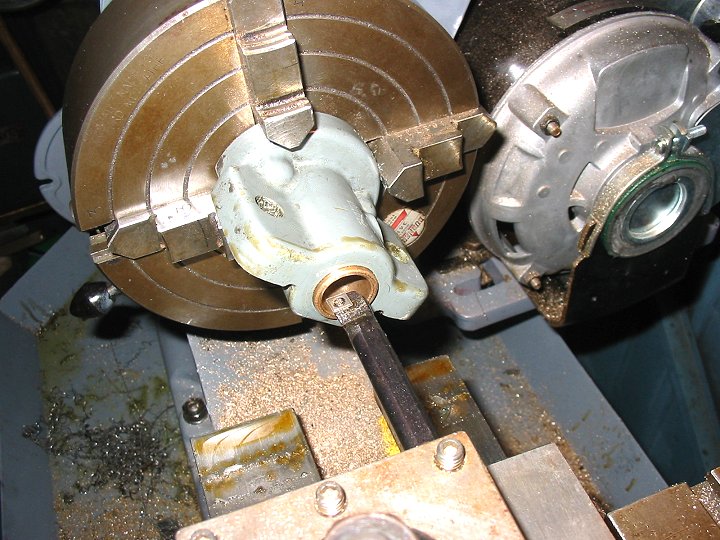Pulley Countershaft and Clutch
I'm lucky that my ML7 came complete with a clutch. These were not standard, but a cost option available when the Lathe was ordered, and models with a clutch are much sought after. Why, you ask? Well that's because with a clutch you don't have to keep stopping and starting the motor every time you need to make a measurement or check something on the part. Most single phase motors designed for continuous or intermittent duty don't take kindly to being stopped and started on a frequent basis. The folowing quote is taken from Tony Griffiths excellent Lathes.co.uk site and describes it like this:
"Whilst all Super 7s have a clutch fitted as standard, on the ML7 this was an optional extra - but one well worth having. Unfortunately 1-phase motors are not the most reliable of devices. They are best run near their rated capacity all the time (i.e. worked nearly flat out); if the motor is switched on and off frequently against "no load" the windings will be damaged and, if run through a cycle where it is started, worked briefly, stopped and started again, the capacitor will fail prematurely. "
The clutch does make the lathe a joy to use as you can just knock the lever in to stop the chuck and then flick it out again to start it spinning after you've measured the part and determined how much more to cut, or checked the finish. It seems to make the jobs go a lot quicker too. Of course this luxury has paid the usual price, and 38 years of wear has caught up in this area too. No surprise really...
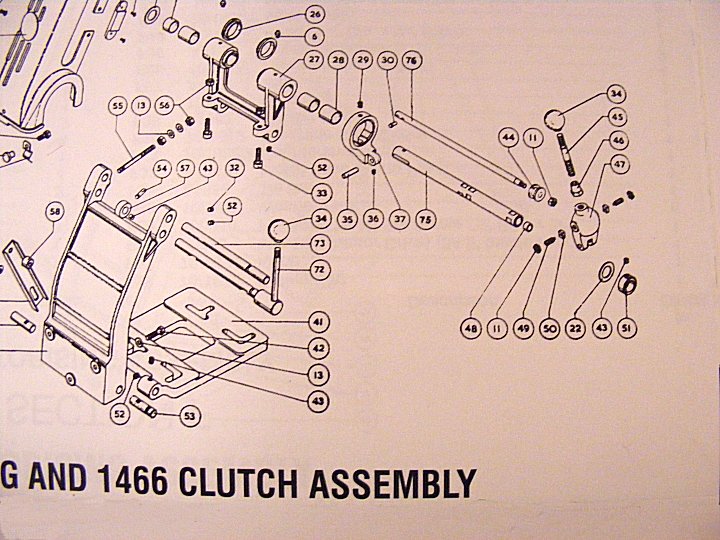
In the photograph above taken from the ML7 operating manual, you can see the countershaft (fig. 75) the actuating shaft (fig. 76) and the thrust ring (fig. 44). These were the parts that had worn badly on my lathe. Suprisingly, the 'working' end of the clutch with the brake shoes running inside the cast pulley at the other end of this was absolutely fine, and needed nothing more than a clean up.
The countershaft had worn very badly where it runs through the bushes in the Swing Head Assembly (fig. 27). This was almost certainly due to lack of lubrication, and the wear made the shaft rotate somewhat eccentrically as the pulley drove it around, which led to a fair bit of vibration. The clutch actuating shaft that runs through the middle of this was only subject to sliding wear, but looked like it was bent to a tiny degree on one end, and was becoming very stiff to operate, and the bronze thrust ring was severely worn in the middle where it constantly runs against hardened pins.
Sadly Myford don't make these parts anymore, so unless you can make them yourself you're going to be a bit snookered. The countershaft is 3/4" diameter by 13" long, and has a 3/8" hole drilled and reamed all the way through. To drill this deep and keep it straight and true is a fairly daunting task unless you have access to a gun drill, but I manage to use a more modern solution to achieve it.
I took a ground 3/4" diameter length of Silver Steel to a Company that made press tools for me, and got them to wire EDM the hole for me. EDM (Electro Discharge Machining) uses a high-frequency, high-intensity spark to 'erode' metal away, so can cut hardened steel like butter. A 'Hole Popper', or fast hole EDM driller was used to put a 1mm hole through the middle in around 90 seconds, then it was transferred on to the wire EDM machine and the wire oscillated in a circle to machine the 3/8" bore.
After that, all I had to to do was mill a slot through to the bore, cross-drill the slot, and mill 6 flats for the locking grub screws, and the new countershaft was ready to go. The actuating shaft just need screwcutting on one end and a hole cross-drilled. A new thrust ring was then turned up from hard Phosphor Bronze.
In the following pictures you can see the wear on the old shaft and compare it with the new parts made. The eccentric wear step that can be seen at about 1.25" in from the left-hand end of the old shaft on top is actually around 0.010" deep.
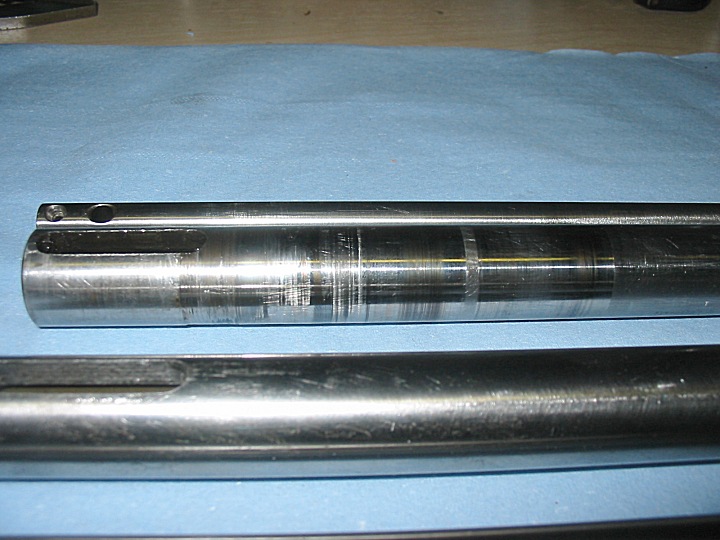
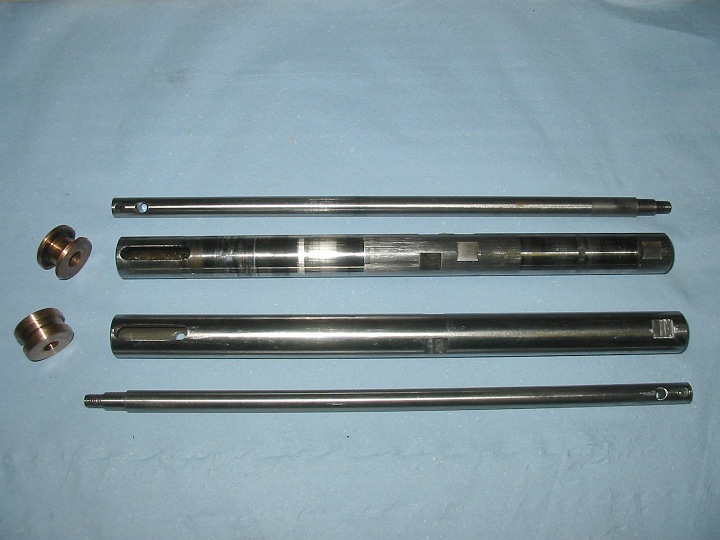
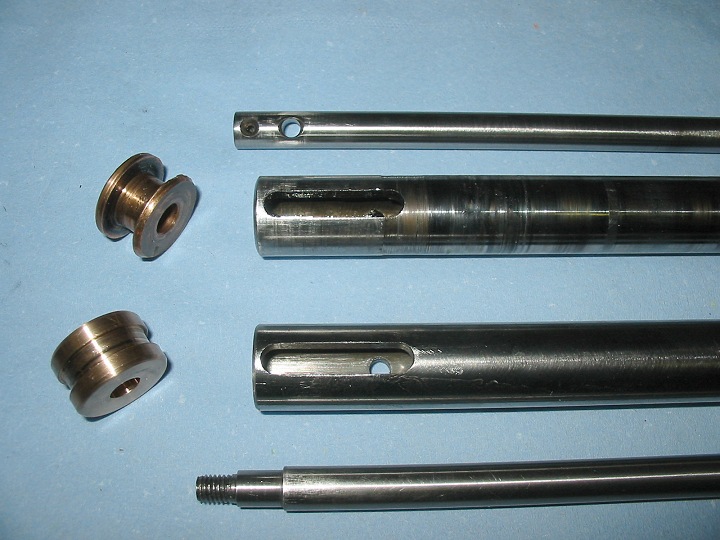
The next job was to fix the swing head assembly.
On the ML7 lathes the swing head is used when the belt position needs to be adjusted between the pulleys, or the belt needs tensioning. A lever on the right-hand side (fig. 72 in top diagram) is pulled, and this pivots the eccentric shaft (fig. 73) which slackens the belt and allows it to be moved. Belt tension is adjusted up by the screw and locknut shown just below the swing head (figs. 33 & 52).
The swing head itself is a square 'U' shaped aluminium casting, and with all the the pressure from the tensioned pulley concentrating the force on one end it can twist if the tension adjusters are not set correctly. This is exactly what had happened to mine, and as result the bore of the two Oilite bearings for the countershaft was out of line by around 3/16" with the main body of the casting. I didn't fancy trying to bend the casting back into line as I figured out that the extra stress - now in the opposite direction - may snap the aluminium casting into several pieces if I attempted this.
This is another part that Myford don't make any more, but luckily it is exactly the same as a standard ML7 swing head, except for the fact that is about 5/16" or so shorter on the pulley bearing side, where Myford machined it back to suit. I spent a little time searching on evil-bay for a second hand standard ML7 part (no point looking for a clutch model - rare as Hens Teeth). There were several for sale, but as soon as I emailed the seller asking them to check for twist they unfortunately confirmed it was evident on their parts as well. I did eventually find a good one, and once this finally arrived it was given new Oilite bearings, a repaint, then machined back to the correct size. Pictures follow, including the slightly Heath-Robinson setup to hold the part without marking the new paintwork. I didn't plan that bit too well did I?
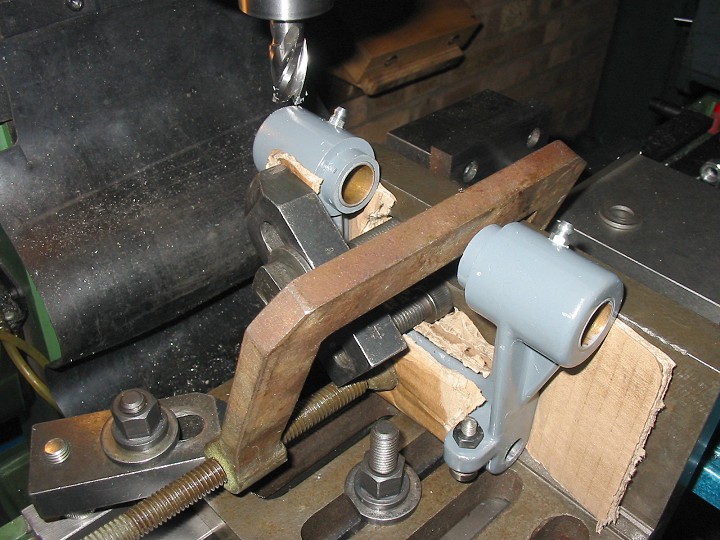


The drive end was then re-assembled with new belts all round, and to finish it off I put a new motor on the Lathe.
There was nothing actually wrong with the old motor, except for the fact that it was a 1/4" HP single-phase motor from a washing machine! It had given good service when in use, but was probably just a little bit too small to do the ML7 justice, so a brand new UK made 1 HP single-phase motor was sourced and fitted. I had to search around a little bit for this, as I also wanted the motor to be the correct B56 frame resilient mount item that Myford had originally specified. The resilient mount holds the motor in a rubber-mounted cradle which isolates the Lathe from any motor vibration, which is beneficial to both the part being turned and more pleasant for the operator using it. The 1 HP is a little bit more than Myford originally used, as they specified a 3/4 HP motor, but well within the Lathes design envelope to use.
You can compare the old and new motors that can just be seen in the pictures below.

